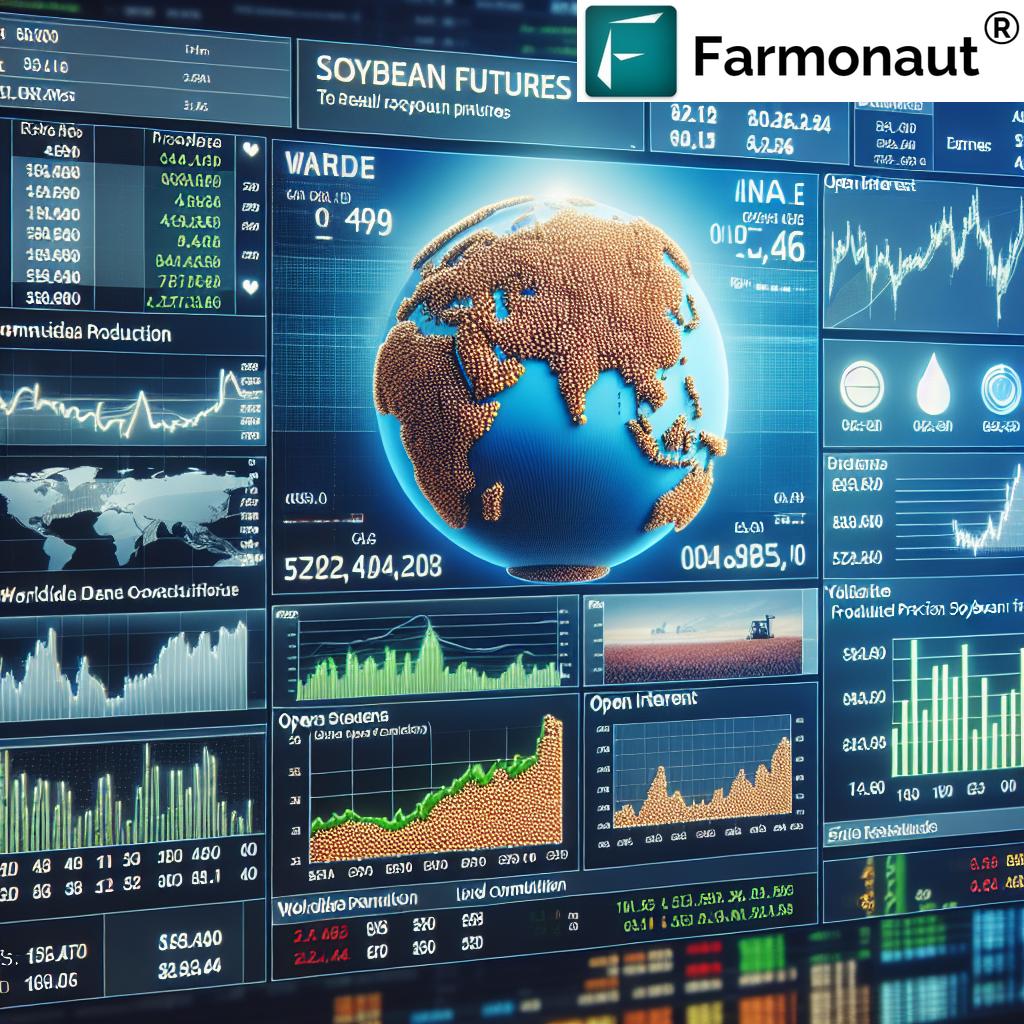Mastering Soybean Futures: Farmonaut’s Guide to Brazilian Market Analysis and Risk Management Strategies

“Brazil accounts for approximately 50% of global soybean exports, significantly influencing international market prices.”
Welcome to Farmonaut’s comprehensive guide on mastering soybean futures, with a special focus on Brazilian market analysis and risk management strategies. As pioneers in agricultural technology, we understand the intricate dynamics of the soybean market and its global impact. In this blog post, we’ll delve deep into the world of soybean futures trading, exploring the latest trends, market forces, and advanced agritech tools that can give traders a competitive edge.
Understanding the Brazilian Soybean Market
The Brazilian soybean market plays a pivotal role in global agricultural commodities. As one of the world’s largest producers and exporters of soybeans, Brazil significantly influences international price trends and market dynamics. Let’s explore the key factors that shape this market:
- Production Regions: Major soybean-producing states include Mato Grosso, Paraná, and Rio Grande do Sul
- Export Trends: Analyzing seasonal patterns and long-term growth in Brazilian soybean exports
- Climate Impacts: Understanding how weather patterns affect crop yields and market prices
- Global Demand: Examining the influence of international buyers, particularly China, on Brazilian soybean prices
At Farmonaut, we leverage advanced satellite technology to monitor crop health and predict yields across these crucial regions. Our web application provides real-time insights that can be invaluable for traders and analysts in the soybean futures market.
Soybean Futures: Contract Specifications and Market Mechanics
To effectively trade soybean futures, it’s crucial to understand the contract specifications and market mechanics. Here’s what you need to know:
- Contract Size: Typically 5,000 bushels of soybeans
- Price Quotation: Cents per bushel
- Trading Hours: Varies by exchange, but often includes both day and night sessions
- Delivery Months: January, March, May, July, August, September, November
- Last Trading Day: The business day prior to the 15th calendar day of the delivery month
Understanding these specifications is crucial for developing effective trading strategies and managing risk in the soybean futures market.
Price Discovery in the Brazilian Soybean Market
Price discovery in the Brazilian soybean market is a complex process influenced by various factors. As agricultural market analysts, we at Farmonaut closely monitor these elements:
- Supply and Demand Dynamics: Domestic consumption vs. export demand
- Currency Exchange Rates: Fluctuations in the Brazilian Real against the US Dollar
- Transportation Costs: Impact of logistics on FOB (Free On Board) prices
- Global Market Trends: Influence of other major producers like the United States and Argentina
- Government Policies: Trade agreements, export taxes, and subsidies
Our advanced agritech tools, including satellite-based crop monitoring, provide valuable insights into these factors, helping traders make informed decisions in the soybean futures market.

Advanced Agritech Trading Tools for Soybean Futures
In today’s fast-paced trading environment, leveraging advanced agritech tools is essential for staying ahead in the soybean futures market. At Farmonaut, we offer cutting-edge solutions that combine satellite imagery, artificial intelligence, and data analytics to provide traders with a competitive edge:
- Satellite-Based Crop Monitoring: Real-time insights into crop health and potential yields
- AI-Powered Market Analysis: Predictive models for price trends and market movements
- Weather Forecasting Integration: Accurate climate predictions to anticipate supply fluctuations
- Supply Chain Tracking: Blockchain-based solutions for enhanced transparency in soybean logistics
These tools are accessible through our mobile and web applications, enabling traders to make data-driven decisions from anywhere in the world.
Risk Management Strategies for Soybean Futures Trading
Effective risk management is crucial in the volatile world of soybean futures trading. Here are some key strategies we recommend:
- Hedging: Using futures contracts to offset potential losses in the physical market
- Options Strategies: Employing puts and calls to limit downside risk while maintaining upside potential
- Diversification: Spreading risk across different contract months and related commodities
- Stop-Loss Orders: Implementing automatic exit points to limit potential losses
- Fundamental Analysis: Utilizing Farmonaut’s crop health data to make informed trading decisions
Our API services provide real-time data that can be integrated into your existing risk management systems, enhancing your ability to navigate market volatility.
“Soybean futures contracts typically represent 5,000 bushels, with price fluctuations often measured in cents per bushel.”
Analyzing Open Interest and Volume in Soybean Futures
Understanding open interest and volume is crucial for gauging market sentiment and potential price movements in soybean futures. Here’s what traders should focus on:
- Open Interest Trends: Increasing open interest during price movements can confirm market direction
- Volume Analysis: High volume during price changes often indicates strong market conviction
- Commitment of Traders (COT) Reports: Analyzing positions held by different trader categories
- Spread Trading: Monitoring differences between contract months for arbitrage opportunities
Farmonaut’s data analytics tools can help visualize these trends, providing traders with valuable insights for their decision-making process.
Regional Pricing Dynamics in Brazilian Soybean Markets
Brazil’s vast geography leads to significant regional variations in soybean pricing. Understanding these dynamics is crucial for effective futures trading:
- Mato Grosso: Often sets the baseline for Brazilian soybean prices due to its high production volume
- Paraná: Closer to ports, prices here can reflect export demand more quickly
- Rio Grande do Sul: Weather-sensitive region that can experience significant price volatility
- Port Premiums: Differences in pricing between inland production areas and port regions
Our satellite-based crop monitoring system provides region-specific insights, helping traders anticipate and capitalize on these pricing differentials.
Global Market Forces Impacting Brazilian Soybean Futures
The Brazilian soybean futures market doesn’t operate in isolation. Several global factors significantly influence price movements:
- Chinese Demand: As the world’s largest soybean importer, China’s purchasing patterns greatly affect prices
- U.S. Crop Conditions: Competition between Brazilian and U.S. soybeans impacts global pricing
- Currency Exchange Rates: Fluctuations in the USD/BRL exchange rate affect export competitiveness
- Global Trade Policies: Tariffs, trade agreements, and geopolitical tensions can shift demand patterns
- Biofuel Mandates: Changes in biodiesel policies can impact soybean oil demand and, consequently, soybean prices
Farmonaut’s comprehensive market analysis tools help traders stay ahead of these global trends, providing a holistic view of the soybean futures landscape.
Leveraging Farmonaut’s Technology for Soybean Futures Trading
At Farmonaut, we’re committed to empowering traders with cutting-edge technology for informed decision-making in the soybean futures market. Our suite of tools includes:
- Satellite-Based Crop Monitoring: Real-time insights into crop health and potential yields
- AI-Powered Market Analysis: Predictive models for price trends and market movements
- Blockchain-Based Traceability: Enhance supply chain transparency and verify product origins
- Weather Forecasting Integration: Accurate climate predictions to anticipate supply fluctuations
- Custom API Solutions: Integrate our data seamlessly into your existing trading platforms
To explore how Farmonaut can enhance your soybean futures trading strategies, visit our API Developer Docs or download our mobile apps:
Analyzing Volatility Patterns in Soybean Futures
Volatility analysis is a crucial aspect of soybean futures trading. Understanding volatility patterns can help traders make more informed decisions about entry and exit points, as well as risk management strategies. Here’s what to consider:
- Seasonal Volatility: Soybean futures often experience increased volatility during key growing and harvesting periods
- Event-Driven Volatility: Major USDA reports, weather events, or geopolitical developments can cause sudden price swings
- Implied Volatility: Analyzing options prices to gauge market expectations of future volatility
- Historical Volatility: Comparing current price movements to past patterns for context
- Volatility Skew: Understanding the differences in implied volatility across different strike prices and expirations
Farmonaut’s advanced analytics tools can help visualize these volatility patterns, enabling traders to develop more robust strategies for managing risk and capitalizing on market movements.
Soybean Futures Price Comparison and Risk Analysis
To provide a clear overview of the Brazilian soybean futures market, we’ve compiled a comprehensive table comparing prices, volatility, and risk across different regions and contract expirations:
| Region | Current Spot Price (USD/bushel) | Near-Term Futures Price (1-3 months) | Mid-Term Futures Price (4-6 months) | Long-Term Futures Price (7-12 months) | Price Volatility (%) | Open Interest | Risk Rating |
|---|---|---|---|---|---|---|---|
| Mato Grosso | 10.25 | 10.50 | 10.75 | 11.00 | 15% | 150,000 | Medium |
| Paraná | 10.40 | 10.65 | 10.90 | 11.15 | 18% | 120,000 | Medium-High |
| Rio Grande do Sul | 10.35 | 10.60 | 10.85 | 11.10 | 20% | 100,000 | High |
This table provides a snapshot of the market, highlighting regional differences and potential opportunities for traders. It’s important to note that these values are estimates and can change rapidly based on market conditions.
Developing a Comprehensive Soybean Futures Trading Strategy
Creating a robust trading strategy for soybean futures requires a multifaceted approach. Here are key elements to consider:
- Fundamental Analysis: Utilize Farmonaut’s crop health data and market reports to assess supply and demand dynamics
- Technical Analysis: Employ chart patterns, indicators, and trend lines to identify potential entry and exit points
- Risk Management: Implement stop-loss orders and position sizing based on your risk tolerance
- Spread Trading: Consider opportunities in calendar spreads or inter-commodity spreads (e.g., soybean-corn ratio)
- Options Strategies: Use options to hedge positions or generate income through strategies like covered calls
- Continuous Education: Stay informed about market developments, policy changes, and technological advancements in agriculture
By integrating these elements and leveraging Farmonaut’s advanced agritech tools, traders can develop a comprehensive strategy that adapts to the dynamic soybean futures market.
The Role of Weather in Soybean Futures Trading
Weather conditions play a crucial role in soybean production and, consequently, in futures trading. Understanding and anticipating weather patterns can provide a significant edge:
- Drought Impact: Extended dry periods can significantly reduce yields, potentially driving up futures prices
- Excessive Rainfall: Too much rain can delay planting or harvesting, affecting crop quality and quantity
- Temperature Fluctuations: Extreme heat or unexpected frosts can damage crops at critical growth stages
- Long-Term Climate Trends: Understanding the effects of phenomena like El Niño or La Niña on Brazilian agriculture
Farmonaut’s satellite-based monitoring system provides up-to-date information on weather patterns and their potential impact on soybean crops, helping traders anticipate market movements.
Navigating Regulatory Landscape in Brazilian Soybean Futures
Understanding the regulatory environment is crucial for traders in the Brazilian soybean futures market. Key aspects include:
- Exchange Regulations: Familiarize yourself with the rules set by major exchanges like B3 (Brasil Bolsa Balcão)
- Margin Requirements: Stay updated on initial and maintenance margin requirements for futures contracts
- Position Limits: Be aware of any restrictions on the number of contracts you can hold
- Reporting Requirements: Understand obligations for reporting large positions to regulatory authorities
- Tax Implications: Consider the tax treatment of futures trading gains and losses in your jurisdiction
While Farmonaut is not a regulatory body, our market analysis tools can help you stay informed about regulatory changes that may impact trading strategies.
Farmonaut’s Subscription Plans for Soybean Futures Traders
To support traders in the soybean futures market, Farmonaut offers tailored subscription plans that provide access to our advanced agritech tools and data analytics. Here’s an overview of our pricing options:
Frequently Asked Questions (FAQ)
Q: How can Farmonaut’s satellite data improve my soybean futures trading?
A: Our satellite-based crop monitoring provides real-time insights into crop health, potential yields, and weather impacts, helping you make more informed trading decisions.
Q: Is Farmonaut’s platform suitable for both beginner and experienced traders?
A: Yes, our platform is designed to cater to traders of all experience levels, offering both basic and advanced analytics tools.
Q: How often is the data updated on Farmonaut’s platform?
A: We provide daily updates on crop conditions and weather patterns, ensuring you have the most current information for your trading strategies.
Q: Can I integrate Farmonaut’s data into my existing trading systems?
A: Absolutely. Our API services allow for seamless integration of our data into your trading platforms and risk management systems.
Q: Does Farmonaut offer any educational resources for soybean futures trading?
A: While we focus on providing data and analytics, our blog and newsletter offer insights into market trends and how to interpret agricultural data for trading purposes.
Conclusion: Empowering Soybean Futures Traders with Farmonaut
As we’ve explored throughout this comprehensive guide, mastering soybean futures trading in the Brazilian market requires a deep understanding of market dynamics, advanced analytical tools, and robust risk management strategies. At Farmonaut, we’re committed to empowering traders with cutting-edge agritech solutions that provide real-time insights into crop health, weather patterns, and market trends.
By leveraging our satellite-based monitoring, AI-powered analytics, and comprehensive data services, traders can gain a significant edge in the complex world of soybean futures. Whether you’re analyzing regional pricing dynamics, assessing global market forces, or developing sophisticated trading strategies, Farmonaut’s tools are designed to support your success.
We invite you to explore our platform, integrate our API into your trading systems, and utilize our mobile apps to stay connected to the pulse of the soybean market. With Farmonaut, you’re not just trading – you’re trading with insight, precision, and confidence.
To get started with Farmonaut and revolutionize your approach to soybean futures trading, visit our web application or download our mobile apps today. Together, let’s cultivate success in the dynamic world of agricultural commodities.




















